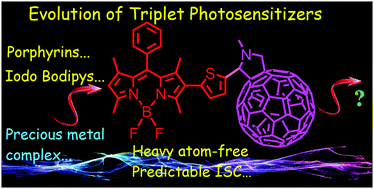Triplet photosensitizers: from molecular design to applications
Abstract
Triplet photosensitizers (PSs) are compounds that can be efficiently excited to the triplet excited state which subsequently act as

* Corresponding authors
a
State Key Laboratory of Fine Chemicals, School of Chemical Engineering, Dalian University of Technology, E 208 Western Compus, 2 Ling-Gong Road, Dalian 116012, P.R. China
E-mail:
zhaojzh@dlut.edu.cn
Triplet photosensitizers (PSs) are compounds that can be efficiently excited to the triplet excited state which subsequently act as

 Please wait while we load your content...
Something went wrong. Try again?
Please wait while we load your content...
Something went wrong. Try again?
J. Zhao, W. Wu, J. Sun and S. Guo, Chem. Soc. Rev., 2013, 42, 5323 DOI: 10.1039/C3CS35531D
To request permission to reproduce material from this article, please go to the Copyright Clearance Center request page.
If you are an author contributing to an RSC publication, you do not need to request permission provided correct acknowledgement is given.
If you are the author of this article, you do not need to request permission to reproduce figures and diagrams provided correct acknowledgement is given. If you want to reproduce the whole article in a third-party publication (excluding your thesis/dissertation for which permission is not required) please go to the Copyright Clearance Center request page.
Read more about how to correctly acknowledge RSC content.
 Fetching data from CrossRef.
Fetching data from CrossRef.
This may take some time to load.
Loading related content
